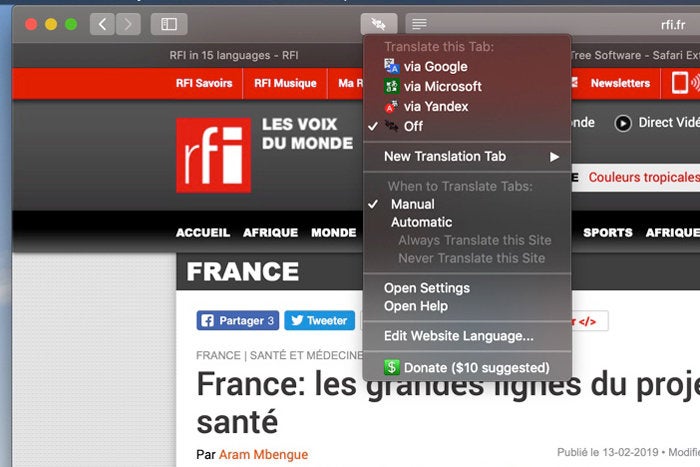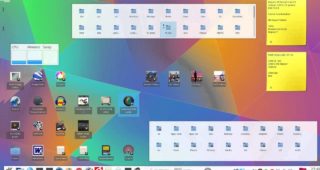As a precautionary health measure for our support specialists in light of COVID-19, we're operating with a limited team. If you need help with a product whose support you had trouble reaching over the phone, consult its product-specific Help Center. More ways to access Google:. Google Search widget — Search from your home screen with the new Google widget built for iOS 14. Choose from 2 widgets, giving you a quick search bar in both sizes, and shortcuts to choose how you Search with Lens, Voice, and Incognito in the medium size widget. Google Lens — Search with your camera, copy. Search the world's information, including webpages, images, videos and more. Google has many special features to help you find exactly what you're looking for.
- Google Translate Plugin Safari Mac
- Google Translate Plugin Mac
- Google Translate Widget Mac
- Google Translate Widget Mac Os
Google Tag Manager (GTM) is Google’s free tool for everyone to manage and deploy analytics and marketing tags as well as other code snippets using an intuitive web UI. To learn more about this tool, visit the official website. This plugin places the GTM container code snippets onto your wordpress website so that you do not need to add this. Download software about android like uptodown app store, xender, shareit - connect & transfer.

Description
Google Tag Manager (GTM) is Google’s free tool for everyone to manage and deploy analytics and marketing tags as well as other code snippets
using an intuitive web UI. To learn more about this tool, visit the official website.
This plugin places the GTM container code snippets onto your wordpress website so that you do not need to add this manually.
Multiple containers are also supported!
The plugin complements your GTM setup by pushing page meta data and user information into the so called data layer.
Google’s official help pages includes more details about the data layer.

You can also add your Google Optimize container with the recommended code setup
Some parts of the plugin require PHP 5.6 newer.
PHP 7.0 or newer is recommended.
Please note that PHP 5.6 is nearing its end of life cycle thus it is recommended to upgrade. If you are not sure which version you are using, please contact
your hosting provider for support.
GTM container code placement

The original GTM container code is divided into two parts: The first part is a javascript code snippet that is added to the <head>
section of every page of the website. This part is critical to enable all features of GTM, and this plugin helps to place this part
correctly on your site. The second part is an iframe snippet that acts as a failsafe/fallback should users’ JavaScript be disabled.
Google recommends – for best performance – to place this code snippet directly after the opening <body> tag on each page.
Albeit not ideal, it will work when placed lower in the code. This plugin provides a code placement option for the second code snippet.
Inherently, WordPress does not offer a straight-forward solution to achieve this, however Yaniv Friedensohn showed me a solution
that works with most themes without modification:
http://www.affectivia.com/blog/placing-the-google-tag-manager-in-wordpress-after-the-body-tag/
I added this solution to the plugin, currently as an experimental option.
Sites using the Genesis Framework should choose the “Custom” placement option. No theme modification is needed for this theme
however, the Google Tag Manager container code will be added automatically.
Basic data included
- post/page titles
- post/page dates
- post/page category names
- post/page tag names
- post/page author ID and names
- post/page ID
- post types
- post count on the current page + in the current category/tag/taxonomy
- logged in status
- logged in user role
- logged in user ID (to track cross device behaviour in Google Analytics)
- logged in user email address (to comply with GTM terms of service do not pass this on to Google tags)
- site search data
- site name and id (for WordPress multisite instances)
Browser / OS / Device data
(beta)
- browser data (name, version, engine)
- OS data (name, version)
- device data (type, manufacturer, model)
Data is provided using the WhichBrowser library: http://whichbrowser.net/
Weather data
(beta)
Push data about users’ current weather conditions into the dataLayer. This can be used to generate weather-related
audience/remarketing lists on ad platforms and allows for user segmentation in your web analytics solutions:
- weather category (clouds, rain, snow, etc.)
- weather description: more detailed data
- temperature in Celsius or Fahrenheit
- air pressure
- wind speed and degrees
Weather data is queried from Open Weather Map. Depending on your websites traffic, additional fees may apply:
http://openweathermap.org/price
An (free) API key from OpenWeatherMap is required for this feature to work.
ipstack.com is used to determine the site visitor’s location. A (free) API key from IPStack.com is required for this feature to work:
https://ipstack.com/product
Media player events
(experimental)
Track users’ interaction with any embedded media:
- YouTube
- Vimeo
- Soundcloud
DataLayer events can be chosen to fire upon media player load, media is being played, paused/stopped and optionally when
the user reaches 10, 20, 30, …, 90, 100% of the media duration.
Tracking is supported for embedded media using the built-in oEmbed feature of WordPress as well as most other media plugins
and copy/pasted codes. Players injected into the website after page load are not currently supported.
Scroll tracking
Fire tags based on how the visitor scrolls from the top to the bottom of a page.
An example would be to separate “readers” (who spend a specified amount of time on a page) from “scrollers”
(who only scroll through within seconds). You can use these events to fire Analytics tags and/or remarketing/conversion tags
(for micro conversions).
Scroll tracking is based on the solution originally created by
- Nick Mihailovski
- Thomas Baekdal
- Avinash Kaushik
- Joost de Valk
- Eivind Savio
- Justin Cutroni
Original script:
http://cutroni.com/blog/2012/02/21/advanced-content-tracking-with-google-analytics-part-1/
Google Ads remarketing
Google Tag Manager for WordPress can add each dataLayer variable as a Google Ads remarketing custom parameter list.
This enables you to build sophisticated remarketing lists.
Blacklist & Whitelist Tag Manager tags and variables
To increase website security, you have the option to white- and blacklist tags/variables.
You can prevent specific tags from firing or the use of certain variable types regardless of your GTM setup.
If the Google account associated with your GTM account is being hacked, an attacker could easily
execute malware on your website without accessing its code on your hosting server. By blacklisting custom HTML tags
and/or custom JavaScript variables you can secure the Tag Manager container.
Integration
Google Tag Manager for WordPress integrates with several popular plugins. More integration to come!
- Contact Form 7: fire an event upon successful form submission
- WooCommerce:
- Classic e-commerce:
- fire an event when visitors add products to their cart
- capture transaction data to be passed to your ad platforms and/or Analytics
- capture necessary remarketing parameters for Google Ads Dynamic Remarketing
- Enhanced e-commerce (beta):
- implementation of Enhanced E-commerce
- Does not support promotions since WooCommerce does not have such a feature (yet)
- Does not support refunds
- Classic e-commerce:
Installation
- Upload
duracelltomi-google-tag-manager-for-wordpressto the/wp-content/plugins/directory - Activate the plugin through the ‘Plugins’ menu in WordPress
- Go to Settings / Google Tag Manager and enter your Google Tag Manager container ID and set additional options
FAQ
How can I …
Tutorials for various Google Tag Manager settings and implementation are available on my website:
https://gtm4wp.com/how-to-articles/
PayPal / 3rd party payment gateway transactions in WooCommerce are not being tracked in Google Analytics
PayPal and some other 3rd party payment gateways do not redirect users back to your website upon successful transaction by default.
It offers the route back for your customer but it can happen that users close the browser before arriving at your thankyou page
(aka. order received page). This means that neither Google Analytics tags or any other tags have the chance to fire.
Enable auto-return in your payment gateway settings. This will instruct them to show a quick info page after payment
and redirect the user back to your site. This will improve the accuracy and frequency of tracked transactions.
Why isn’t there an option to blacklist tag/variable classes
Although Google recommends to blacklist tags and variables using classes, people struggle to know
which tags/variables gets affected. Therefore I opted for individual tags and variables rather than classes
on the blacklist tabs.
Regarding variables; ensure they are not part of any critical tags as blacklisting such variables will render said tags useless.
Google Translate Plugin Safari Mac
How can I track scroll events in Google Tag Manager?
Google Tag Manager supports basic scroll depth tracking based on percentage or pixels natively. This plugin adds
additional scroll tracking events, more focused on capturing the users’ intent and/or engagement.

There are five dataLayer events you can use in your rule definitions:
- gtm4wp.reading.articleLoaded: the content has been loaded
- gtm4wp.reading.startReading: the visitor started to scroll. The
timeToScrolldataLayer variable stores duration since the article loaded (in seconds) - gtm4wp.reading.contentBottom: the visitor reached the end of the content (not the page!).
timeToScrolldataLayer variable updated - gtm4wp.reading.pagebottom: the visitor reached the end of the page.
timeToScrolldataLayer variable updated - gtm4wp.reading.readerType: based on time spent since article loaded we determine whether the user is a ‘scanner’ or ‘reader’ and store this in the
readerTypedataLayer variable
Example use cases: using these events as triggers, you can fire Google Universal Analytics and/or Google Ads remarketing/conversion tags
to report micro conversions and/or to serve ads only to visitors who spend more time reading your content.
Can I exclude certain user roles from being tracked?
This is easily managed through GTM itself. If you want to exclude logged in users or users with certain user roles,
use the corresponding dataLayer variable (visitorType) and an exclude filter in Google Tag Manager.
https://gtm4wp.com/how-to-articles/how-to-exclude-admin-users-from-being-tracked/
How do I put the Google Tag Manager container code next to the opening body tag?
By default the plugin places the iframe tag in the footer of the page. To change it, go to the plugin’s admin section
and select “Custom” from the placement settings. Unless you use the Genesis Framework theme, you will also need to
edit your template files.
Google Translate Plugin Mac
Go to wp-content/plugins/themes/<your theme dir> and edit header.php.
In most cases you will find the opening <body> tag here. If you can not find it, contact the author of the theme and
ask for instructions.
Google Translate Widget Mac
Create a new line right below the body tag and insert this line of code:
Be careful not to place this line within any <div>, <p>, <header>, <article> tags.
It may break your theme.
There is also an option named “Codeless” which attempts to place the container code correctly
without additional theme tweaks. It may or may not work, this is an experimental feature, use it accordingly.
Why can’t this plugin insert the container snippet after the opening body tag automatically?
Google Translate Widget Mac Os
Currently WordPress has two ‘commands’ or ‘hooks’ that a programmer can use: one for the <head> section and
one for the bottom of <body>. There is no way to inject any content after the opening <body> tag without manually
editing your template files. Fortunately some theme authors already resolved this so in some cases you do not need
to edit your template.
I suggest that try the Custom placement (easiest) and use Google Tag Assistant Chrome browser extension to check
whether the container code is placed as expected. If it shows an error, go ahead and edit your theme manually.
Facebook like/share/send button events do not fire for me, why?
It is a Facebook limitation. Click event tracking is only available for html5/xfbml buttons.
If you or your social plugin inserts the Facebook buttons using IFRAMEs (like Sociable), it is not possible to track likes.
Reviews
